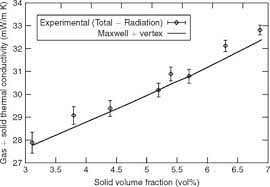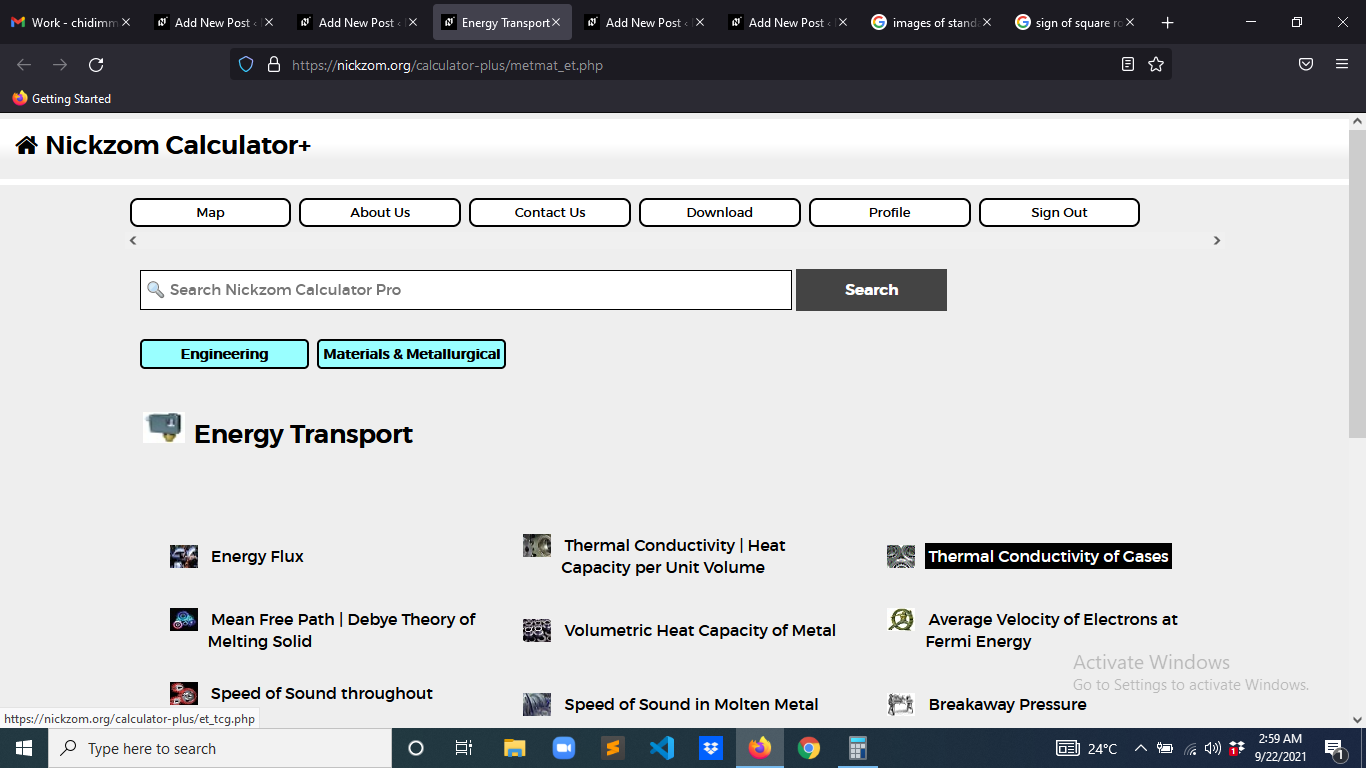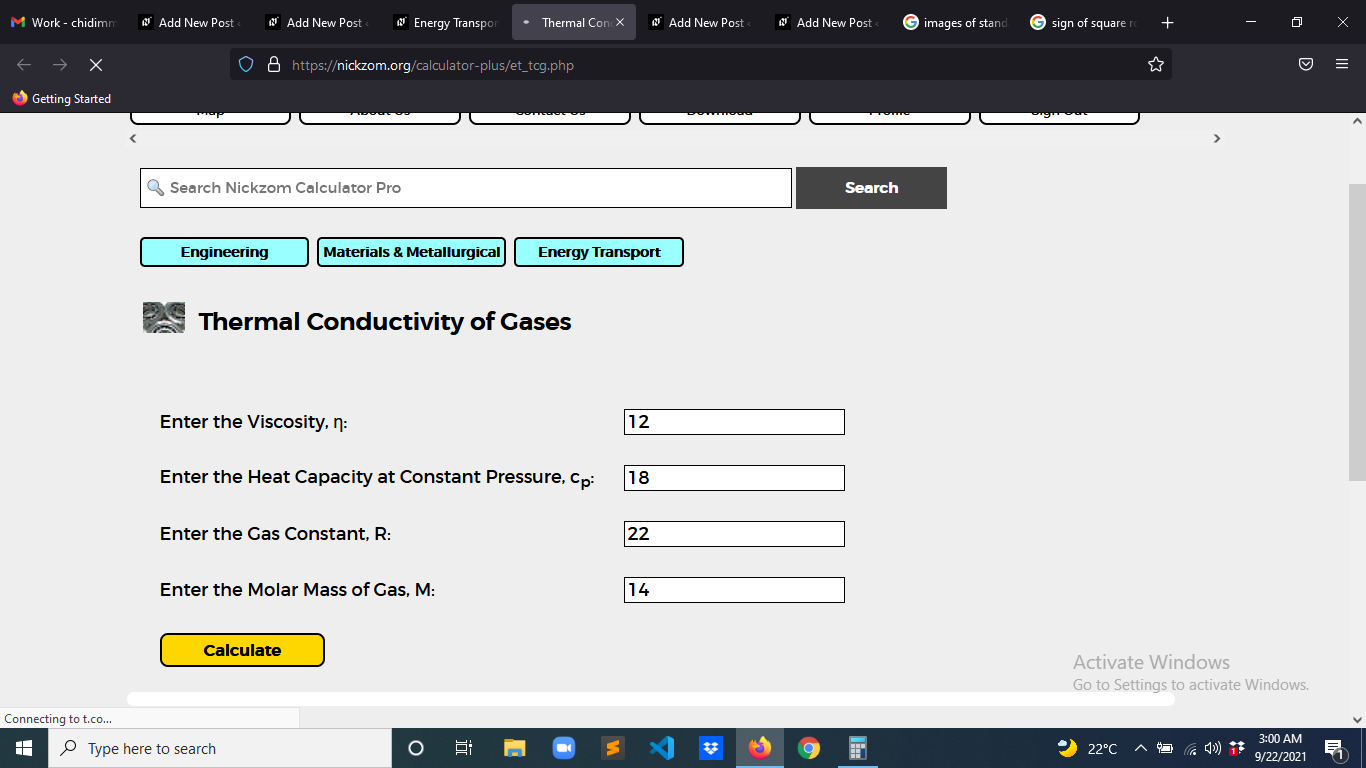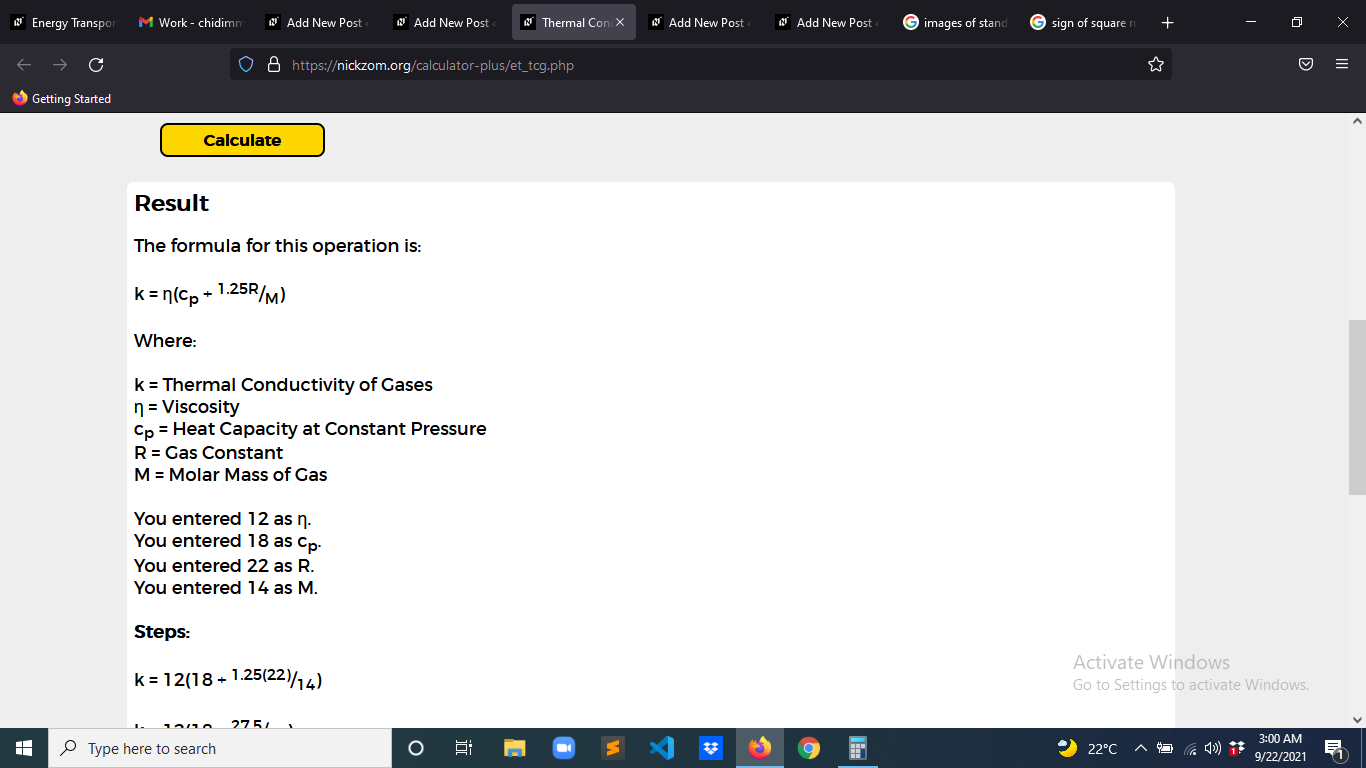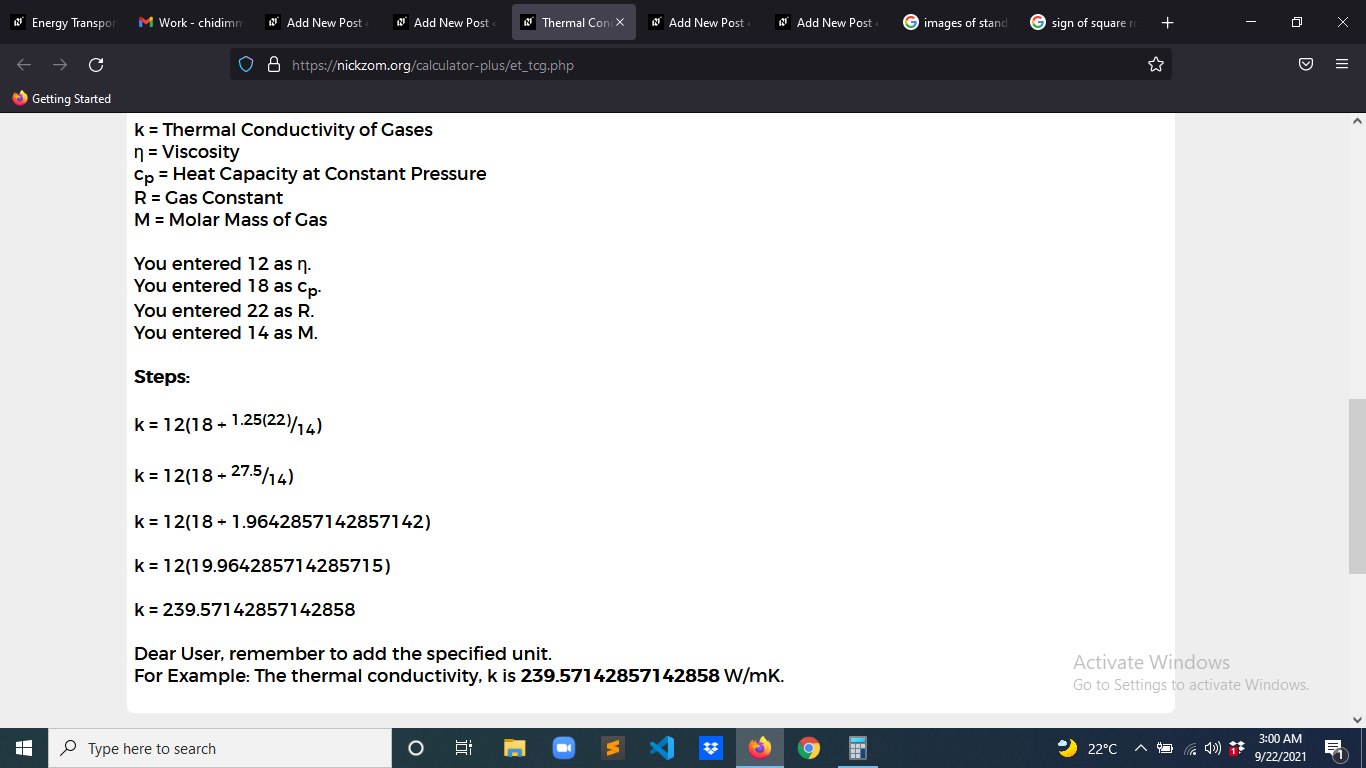How to Calculate and Solve for Thermal Conductivity of Gases | Energy Transport
Last Updated on September 23, 2021
The image above represents thermal conductivity of gases.
To compute for thermal conductivity of gases, four essential parameters are needed and these parameters are Viscosity (η), Heat Capacity at Constant Pressure (cp), Gas Constant (R) and Molar Mass of Gas (M).
The formula for calculating thermal conductivity of gases:
k = η(cp + 1.25R/M)
Where:
k = Thermal Conductivity of Gases
η = Viscosity
cp = Heat Capacity at Constant Pressure
R = Gas Constant
M = Molar Mass of Gas
Let’s solve an example;
Find the thermal conductivity of gases when the viscosity is 12, the heat capacity at constant pressure is 18, the gas constant is 22 and the molar mass of gas is 14.
This implies that;
η = Viscosity = 12
cp = Heat Capacity at Constant Pressure = 18
R = Gas Constant = 22
M = Molar Mass of Gas = 14
k = η(cp + 1.25R/M)
k = 12(18 + 1.25(22)/14)
k = 12(18 + 27.5/14)
k = 12(18 + 1.96)
k = 12(19.96)
k = 239.57
Therefore, the thermal conductivity of gases is 239.57 W/mK.
Calculating the Viscosity when the Thermal Conductivity of Gases, the Heat Capacity at Constant Pressure, the Gas Constant and the Molar Mass of Gas is Given.
η = k / (cp + 1.25R / M)
Where:
η = Viscosity
k = Thermal Conductivity of Gases
cp = Heat Capacity at Constant Pressure
R = Gas Constant
M = Molar Mass of Gas
Let’s solve an example;
Find the viscosity when the thermal conductivity of gases is 40, the heat capacity at constant pressure is 22, the gas constant is 2 and the molar mass of gas is 8.
This implies that;
k = Thermal Conductivity of Gases = 40
cp = Heat Capacity at Constant Pressure = 22
R = Gas Constant = 2
M = Molar Mass of Gas = 8
η = k / (cp + 1.25R / M)
η = 40 / (22 + 1.25(2) / 8)
η = 40 / (22 + 2.5 / 8)
η = 40 / (22 + 0.313)
η = 40 / 22.313
η = 1.79
Therefore, the viscosity is 1.79.
Calculating the Heat Capacity at Constant Pressure when the Thermal Conductivity of Gases, the Viscosity, the Gas Constant and the Molar Mass of Gas is Given.
cp = kη – (1.25R / M)
Where:
cp = Heat Capacity at Constant Pressure
k = Thermal Conductivity of Gases
η = Viscosity
R = Gas Constant
M = Molar Mass of Gas
Let’s solve an example;
Find the heat capacity at constant pressure when the thermal conductivity of gases is 20, the viscosity is 5, the gas constant is 4 and the molar mass of gas is 10.
This implies that;
k = Thermal Conductivity of Gases = 20
η = Viscosity = 5
R = Gas Constant = 4
M = Molar Mass of Gas = 10
cp = kη – (1.25R / M)
cp = (20)(5) – (1.25(4) / 10)
cp = 100 – (5 / 10)
cp = 100 – 0.5
cp = 99.5
Therefore, the heat capacity at constant pressure is 99.5
Calculating the Gas Constant when the Thermal Conductivity of Gases, the Viscosity, the Heat Capacity at Constant Pressure and the Molar Mass of Gas is Given.
R = (kη – cp)M / 1.25
Where:
R = Gas Constant
k = Thermal Conductivity of Gases
η = Viscosity
cp = Heat Capacity at Constant Pressure
M = Molar Mass of Gas
Let’s solve an example;
Find the gas constant when the thermal conductivity of gases is 14, the viscosity is 2, the heat capacity at constant pressure is 8 and the molar mass of gas is 12.
This implies that;
k = Thermal Conductivity of Gases = 14
η = Viscosity = 2
cp = Heat Capacity at Constant Pressure = 8
M = Molar Mass of Gas = 12
R = (kη – cp)M / 1.25
R = (14(2) – 8)12 / 1.25
R = (28 – 8)12 / 1.25
R = (20)12 / 1.25
R = 240 / 1.25
R = 192
Therefore, the gas constant is 192.
Calculating the Molar Mass of Gas when the Thermal Conductivity of Gases, the Viscosity, the Heat Capacity at Constant Pressure and the Gas Constant is Given.
M = 1.25R / (kη – cp)
Where:
M = Molar Mass of Gas
k = Thermal Conductivity of Gases
η = Viscosity
cp = Heat Capacity at Constant Pressure
R = Gas Constant
Let’s solve an example;
Find the molar mass of gas when the thermal conductivity of gases is 4, the viscosity is 6, the heat capacity at constant pressure is 3 and the gas constant is 9.
This implies that;
k = Thermal Conductivity of Gases = 4
η = Viscosity = 6
cp = Heat Capacity at Constant Pressure = 3
R = Gas Constant = 9
M = 1.25R / (kη – cp)
M = 1.25(9) / (4(6) – 3)
M = 11.25 / (24 – 3)
M = 11.25 / 21
M = 0.53
Therefore, the molar mass of gas is 0.53.
Nickzom Calculator – The Calculator Encyclopedia is capable of calculating the thermal conductivity of gases.
To get the answer and workings of the thermal conductivity of gases using the Nickzom Calculator – The Calculator Encyclopedia. First, you need to obtain the app.
You can get this app via any of these means:
Web – https://www.nickzom.org/calculator-plus
To get access to the professional version via web, you need to register and subscribe for NGN 2,000 per annum to have utter access to all functionalities.
You can also try the demo version via https://www.nickzom.org/calculator
Android (Paid) – https://play.google.com/store/apps/details?id=org.nickzom.nickzomcalculator
Android (Free) – https://play.google.com/store/apps/details?id=com.nickzom.nickzomcalculator
Apple (Paid) – https://itunes.apple.com/us/app/nickzom-calculator/id1331162702?mt=8
Once, you have obtained the calculator encyclopedia app, proceed to the Calculator Map, then click on Materials and Metallurgical under Engineering.
Now, Click on Energy Transport under Materials and Metallurgical
Now, Click on Thermal Conductivity of Gases under Energy Transport
The screenshot below displays the page or activity to enter your values, to get the answer for the thermal conductivity of gases according to the respective parameter which is the Viscosity (η), Heat Capacity at Constant Pressure (cp), Gas Constant (R) and Molar Mass of Gas (M).
Now, enter the values appropriately and accordingly for the parameters as required by the Viscosity (η) is 12, Heat Capacity at Constant Pressure (cp) is 18, Gas Constant (R) is 22 and Molar Mass of Gas (M) is 14.
Finally, Click on Calculate
As you can see from the screenshot above, Nickzom Calculator– The Calculator Encyclopedia solves for the thermal conductivity of gases and presents the formula, workings and steps too.

